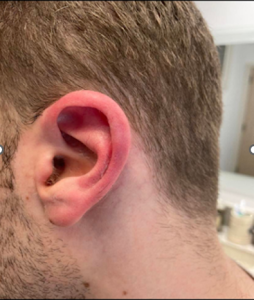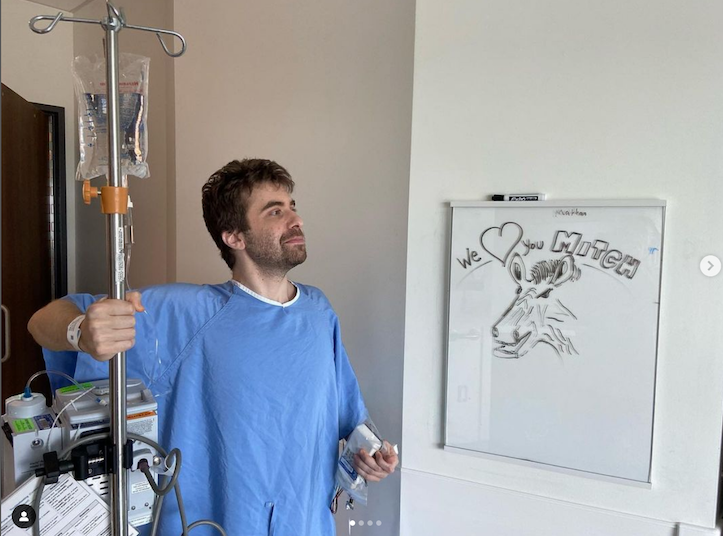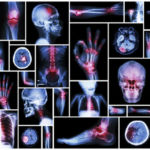For our January Chronic Pain Partners Post, journalist Karina Sturm spoke with Mitch Martow, an EDS advocate from Toronto, Canada. Martow is best known for being the focus of the 2021 released Canadian EDS documentary Bend or Break. In this interview, you’ll get close to Martow and his humorous side while he shares how he copes with having not only EDS but also relapsing polychondritis, as well as suffering a stroke at age 27. He talks about his film Bend or Break, his life as a young man with EDS, his advocacy work, and his plans for the future!
[TW: Brief discussion of suicidal ideation related to Bend or Break]
- Martow as Austin Powers’ Dr. Evil
EDS Journey & Comorbid Conditions
Karina Sturm:
Tell me a little bit about yourself. How old are you, where do you live, and what do you do?
Mitch Martow:
I am Mitch Martow, and I am a 27-year-old EDS zebra-man! Yes, indeed, men with Ehlers-Danlos Syndrome are not just a myth! I can personally attest to the fact that one lives in Thornhill, the quiet suburbs you can find just north of Toronto, Canada. But go ahead and call us unicorns if you must. You’ll have to be crafty to sight this one, given I hear he has a 48-hour sleep cycle, twice as long as his human relatives (awake 30 hours a day, then asleep 18 hours)! Make sure you catch him in the first 20 hours he’s awake, or the exhausted creature may aggressively hiss at you… In those first hours of wakefulness where productivity is actually possible, I (back to first person again) tirelessly focus my days on two major goals: EDS/invisible disability advocacy and endless doctor appointments so that I can stay alive to continue that advocacy. Better make the most of it until it all goes kaput!
I am an administrator for EDS Canada’s Facebook page, as well as a moderator for our Facebook support groups, one of which is an international group specifically for men with EDS! I supply a steady stream of essential resources, meaning funny memes… as well as important EDS/chronic illness news and research updates. The apex of my advocacy efforts came from sharing my EDS journey in a documentary called Bend or Break. In fact, both the title and film are based on my EDS memoir/blog posts that covers the wild ups and downs of my EDS journey. Most recently, I’ve become a professional public speaker. Various schools and universities have begun using the film as an educational tool, and they often invite me to come speak to the students about EDS and invisible disabilities afterward! After my latest presentation, the principal told me that he overhears the students excitedly discussing the important themes of the film, and they’ve prepared plenty of questions for the Q and A at the end of my presentation.
- Martow faces many health challenges.
- His conditions include EDS, a recent stroke and relapsing polychondritis
Sturm:
That’s super exciting, and I am glad your film creates awareness! For those of us who haven’t watched the film (yet), do you want to tell us a bit more about when you were diagnosed with EDS and what the journey was like for you?
Martow:
No! Ok, fine. I was diagnosed with EDS in 2013 when I was 18 years old. It’s hard to have any humor on this one because the journey to that diagnosis was fraught with peril and by far the hardest part of my life, even with all my recent challenges, such as major strokes that resulted in brain tissue death and potentially life-threatening/shortening autoimmune conditions such as relapsing polychondritis (which is degenerative and incurable). I do know that the struggle of finding a diagnosis can be extremely traumatic to many and often takes far longer than the four years it took for me.
I’ll just say that being a 14-year-old angsty teenager that looks healthy but yet is saying he’s too sick to go to school most days is not an enviable position to be in. Forcing oneself to go to school anyway, only to fail your courses due to falling asleep in class, or in hallways between classes, from pain-induced insomnia is not likely to garner much sympathy from your high-expectations school when you don’t even have a diagnosis! I did my best anyway and passed around half my grade 10 classes before it all became untenable. And whaddya know, the second I got half-decent treatments, I returned to my studies and went to a new high school where I quickly graduated with a $3000 university scholarship! Fancy that, eh? Give us what we need to live and have a chance to thrive, and we’ll give you the results you want (if they’re reasonable). Simple!
Sturm:
You already mentioned that you have some really serious other conditions on top of EDS. However, do you have any of the typical complications of EDS?
Martow:
I do have typical EDS complications, plus enough comorbidities to fill a football stadium with zebras! My relatively recent new (clinical) diagnosis, the autoimmune relapsing polychondritis (RP), is even rarer than EDS (1 in 33K). The disease causes a rebellious immune system, with your treasonous legion of white blood cells seeking out any scrap of cartilage in your body that it can find, and sets it all on fire out of spite because you had the AUDACITY to dare to exist!
As we all intimately know, EDS weakens your connective tissue, which, of course, includes cartilage, giving me a devil-spawned yin and yang of diseases. Additionally, I had a major stroke in July 2022 at the age of 27. Apparently, they say that it was related to the polychondritis. My new hematologist, who first visited me at the hospital’s ER stroke unit, said that having my very specific type of rare stroke (Cerebral Venous Thrombosis in the vein of Labbé) at my age has only happened in this planet’s medical history in the amount of “triple digits.” As a reply, I just shrugged and said, “Well, sometimes there are different strokes for different folks.” Bazinga!
Sturm:
Ugh, that sounds like a bunch of conditions nobody really needs. Funnily, I do have a second rare illness as well: a rare bleeding disorder called Factor VII deficiency. It seems unrelated to EDS (as far as science knows), but it does make you wonder why some of us are lucky enough to be these super mutants, doesn’t it? In terms of EDS, what would you say is your biggest challenge throughout everyday life?
Martow:
What I would consider the biggest everyday struggle is more a chain of events: EDS leading to other diseases, leading to yet more diseases, patiently waiting in a single-file line to give you a punch to the face the very second you think you maybe got used to them and had the bruises heal from the last punch! And “chain of events” has a double meaning here because these events chain you down and work together to keep so many dreams, especially childhood ones, out of reach. Of course, my pain worsens my insomnia, but I feel nothing turns you into a different person more than chronic sleep deprivation does. Having severe chronic pain makes it a double whammy since lack of sleep amplifies pain signals. Being awake for 30+ consecutive hours doesn’t mean I exist as myself for those 30 hours. Past the 20-hour point, all I want to do is lock myself in my room in the dark to facilitate faster sleep and fast forward until I can wake up again. Then I sleep for up to 21 hours.
On a very good day, through sheer willpower, I can be productive for the first 12 hours I’m awake, which is more than a typical human’s workday. Meaning even on an ideal day, I have 23% of my existence to get things done, which doesn’t even factor in my endless doctor appointments, grabbing meals, and daily hygiene! This is why I’m extremely impressed with myself for taking three university courses and doing very well in them. However, I now regret designating every possible productive second to school. I didn’t have time for other important life matters, like going on dates with some understanding gals. Additionally, to pull off those courses, I needed to aggressively pursue treatments that almost got me killed and ruined my life enough that I had to put school on hold anyway to this very day! When I was about to go back for my last courses until… surprise! Did someone order a slice of tasty stroke brain damage? Now, I have to depend on lifelong blood thinners to make this uncooperative body survive. I feel 27 year old and blood thinners should never be in the same sentence.
Sturm:
A stroke at that age is rough. I’m so sorry this happened to you. How on earth are you able to cope with all of the crap that happened to you?
Martow:
I cope with these issues by doing what I can to defy them and figure out how I can find fulfillment in my life despite them. Throwing myself into my EDS advocacy efforts is one way, so those future generations won’t have to go through what we did and do. But I also feel a need to seek avenues to throw out positivity (like by trying to make this interview entertaining as well as informative) so I can feel there’s a balance. Of course, that’s hard when true suffering kicks in. I’m never going to stop periodically venting to anyone willing to listen when things feel toughest, but it makes me happy to also share EDS memes, some of which I fully create myself (I always write an original caption when sharing someone else’s meme), or funny Instagram videos with my adorable dog and especially working at a summer camp willing to accommodate my disabilities. I almost get a high feeling off entertaining the little campers for hours on end. Because they don’t care that I’m sick. They don’t care that I haven’t graduated from university yet. They care that I’m making them have so much fun that they approach me in large groups at the end of each camp session to tell me that I “made their summer!” Then in between writing scripts for plays that the counselors (including myself, as I love acting) perform, I can run educational activities and discussions on what EDS is and what it means to have an invisible disability! A much more positive yin and yang for this one!
Bend or Break
Sturm:
How did you become the main focus of the documentary Bend or Break?
Martow:
Simple! I was invited to give a TEDx Talk at York University on EDS. In the audience watching my speech were two young filmmakers named Karan Sharma and Sidhant Sharma. They loved my talk and story and approached me after to congratulate me. They said they wanted to make a film that tells my EDS story if I was willing to share my deepest insecurities with the world to such a degree! I agreed, and so did my entire immediate family, who were also interviewed, to comment on my medical story from their perspective (seeing your loved ones in terrible pain isn’t exactly a cakewalk either). It was not easy on us. However, given how much good has come out from the release of this now 3-time award-winning film, we have zero regrets. So, after you watch, make sure you send the Sharma directors your love! This was a passion project for them to help our beleaguered community, not a financial payday (it’s free on YouTube, after all!)
Sturm:
Yeah, I know one doesn’t become rich from making an EDS documentary. Tell me, what motivated you to share your story with such a large audience?
Martow:
I knew that seeing this kind of documentary as my teenage self or the version of me during those years when I was undiagnosed would have been life-changing. The number one response I get from the many thousands of zebras who have watched and found me to write a response to is that they feel less alone now. More than anything else, I felt alone, given that a young boy is not well equipped to overcome incessant medical gaslighting enough to cause my still very much existing diagnosed PTSD. Zebras or no, after watching many tell me this project that took four years to come to fruition will undoubtedly save lives. Based on my own experience, I have to agree. I may have an interesting story to all, but I want to make sure such a story never happens to anyone else again. That right there was not just my, but our motivation.
- Bend or Break, a documentary on Martow’s life with EDS
Sturm:
Tell me a bit about the filming process and the filmmakers. What was the filming like? And why did the filmmakers want to produce exactly that film?
Martow:
The filming process of Bend or Break was tricky because it was not too long before the COVID pandemic. As you’d imagine, that insanity didn’t exactly help speed up our filming process, especially given we needed to work around my sorry excuse for an immune system and sleep cycle so-called regulation! Regardless, the work and post-production got done in 2021, and then we all held our breath and patiently waited for it to do a lengthy film festival circuit, which is where we picked up those three shiny awards! June 24, 2022, was chosen as the fateful launch day, and the rest is history!
Sturm:
From your perspective, who should watch this film, and why is it so important to watch it?
Martow:
Honestly, I think everyone of an appropriate age should watch Bend or Break! At the risk of sounding like a cliché, it has a little something for everyone! Although, there is a trigger warning due to the discussion of suicide being included, which is why I mention “appropriate age” to watch it. Those with EDS will feel less alone and become proud of our community (plenty of other zebras doing wonderful things are featured in the last 1/3 of the film). The general population needs to be educated on the terrible truth of invisible disabilities and that looks can be deceiving, so you need to give the benefit of the doubt. I’m very keen on psychiatrists/psychologists watching it so they can learn from some of the mistakes of their predecessors. You need to be very careful about giving chronically pained young folks with little personal agency a psychosomatic diagnosis such as Conversion Disorder. Medical gaslighting is not just a nuisance; it’s a life-threatening crime. The film shows exactly that sorrow that I barely survived, still being endured by so many others to this day. Despite being told otherwise, I knew I had a physical illness, I just had no clue on which one, and that took away all my hopes of ever receiving effective treatments.
Sturm:
What is the main takeaway you want your audience to have if they watch Bend or Break?
Martow:
The takeaway I’d love, of course, depends on the lovely person who’s taking the 40 minutes required to sit on the other end of their screen! Many doctors have watched it. Those doctors tell me they now have a better understanding of not just their EDS patients because they get a glimpse into the life of someone with deeply rooted medical trauma to the point of PTSD due to the experience of developing an invisible disability at 14. And so, I’ve received many messages from doctors I don’t personally know, thanking us for providing this helpful perspective. I hope the film also gives anyone holding back the courage to share their most vulnerable moments, that in some places are unfortunately almost still considered to be taboo, to have open public discussions on. Revealing what you survived to your peers who may be in the earlier stages of that difficult journey can mean the world to them. How can someone who survives what we survive be seen as weak? I know seeing a video like the doc when I was a battered teenager in the pre-diagnosis period would have been life-changing/saving for me. I could never have found a video like the documentary until knowing to look up EDS after the diagnosis, which is one of the many reasons why we need to improve the rate at which invisible illnesses are diagnosed. You better believe it’s one of the main goals of my advocacy work!
- Bend or Break won several awards.
Sturm:
What kind of feedback did you get from the folks with EDS who watched the film?
Martow:
The feedback to the film has been truly incredible, and more than my literally damaged brain could ever have imagined or hoped for! So much was felt by so many, given the huge variety of either zebra or human audience that was mentioned earlier, as it meant something special to each individual. Plenty of these responses are scattered all over the internet on IMDB as user reviews (feel free to join in with writing one and rating the film there after watching, it takes 60 seconds to make a free IMDB account), on the YouTube vid itself, on my Bend or Break Instagram account, etc. Honestly, the only negativity we have received at all was concern over Toria’s performance. Toria is the amazing contortionist who herself has EDS and was featured in the film (you can find her on Instagram, too, at Flexy_t). The concern of many is that those bendy movements will cause her trouble in the long term. I understand their worry, but I feel this thought can be compared to NFL professional football players. Those watching, and the players themselves, know the risks they are taking. As long as everyone is aware of the risks, the decision to take them should be made by them. I think it goes without saying that someone watching the documentary wouldn’t try the moves Toria performs themselves. If you’re old enough to be the appropriate age to see the heavy themes included in the doc, you probably already know about all this. Toria’s work added an artistic element to the film and also showcased what the extreme end of EDS flexibility can reach. I hope we can all respect her choice to participate! But of course, you’re free to feel and express your concerns just as she’s free to choose the career that she enjoys so much!
Sturm:
Where can we watch your film?
Martow:
It’s free to see on YouTube with the title “Bend or Break | EDS Documentary (AWARD-WINNING),” and here is also a direct link:
Future Plans
Sturm:
What’s next for you? Any new projects you are planning?
Martow:
What kind of question is that? Of course, there are more chronic illness advocacy projects! I’ve got ‘em up the wazoo! Send a life raft cause I’m drowning in them! Luckily in this metaphor, I’m a far stronger swimmer than I am in real life. These include, but are not limited to, offers for interviews on multiple podcasts, videos over zoom, or text-based keep magically pouring in through my room’s window like the Hogwarts School of Witchcraft and Wizardry acceptance letters in the first Harry Potter movie! Which is great, because I’ll never get bored discussing these topics.
It’s simply too important to not have them discussed globally; awareness needs to come before collective action, after all. I’ve already been filmed in an EDS-based interview hosted by CNN’s awesome reporter Sarah Lazarus. That article should come out any day now! I’ll continue to spread Bend or Break into more schools, as it has yet to break out of Ontario in terms of formal education. You can already see the film in the curriculum of four Ontario schools: the University of York, the University of Guelph, Seneca College, and Blyth Academy, with more on the way! I’ll carry on growing my zebra gaming crew, now 32 members strong! Gaming is such a fun and important way to mentally stimulate ourselves with challenges and to connect with your fellow zebras, given it provides a social aspect even when it’s hard to get together in person, particularly in pandemic times. I had to strictly isolate myself for most of the pandemic, due to being on immunosuppressants. I would have gone even more insane than I already have without having this as a hobby! Also, now that I’ve recovered enough of the writing ability that my stroke stole from me for quite a while (the blood clot is now in jail for theft), I’ll get back to writing my blog posts in my Bend or Break blog group that started all the way in 2011. I’ll continue presenting and doing Q and A’s with students when the professors invite me after the doc is shown in class. I’ll, for the moment, keep posting chronic illness memes and update videos on social media. I also like making skits, including ones focused on EDS!
I’ll definitely keep helping organize various EDS advocacy campaigns (the most recent one being finding an EDS specialist neurosurgeon for Ontario via petitions and contacting our Members of Provincial Parliament, and I’ll most of all continue surviving to the best of my dubious ability despite this no-good, belligerent, TRAITOROUS lump of hypermobile flesh I reluctantly call a body! I also founded an annual tradition this year of inviting zebras who live in/are visiting Toronto in the summer to have a zebra pool party at my place since meeting up with each other is amazingly therapeutic! Through this I finally got to meet you in person!
- Martow was recently interviewed for CNN
You can find Mitch:
- The Bend or Break medical blog group where you can read the memoir the documentary was based on (film covers events up to 2018, the recent blog posts continue the story): https://www.facebook.com/groups/163290407054413
- Direct link to the blog/memoir for if you don’t have Facebook: https://breakorbend.blogspot.com/
- Bend or Break EDS/chronic illness Instagram page: https://www.instagram.com/_bend_or_break_/
- Mitch’s personal Instagram page for non-EDS related fun: https://www.instagram.com/mitchmartow/
- Mitch’s game streaming twitch channel catered to those with chronic illness, but all are welcome to hang out and have fun: https://www.twitch.tv/druidzebra
- Mitch’s discord server for gamers with chronic illness/zebras (we play all kinds of games together!) https://discord.gg/m7MkWByTqt
- Mitch’s brand new TikTok account with content on the way! www.tiktok.com/@mitchmartow
- Mitch’s YouTube Account: https://www.youtube.com/@mitchmartow69
- Mitch’s most recent EDS/invisible disability presentation for students who were shown the the Bend or Break documentary from their teachers: https://youtu.be/Xzo-zdrQi58
Karina Sturm
January 2023









